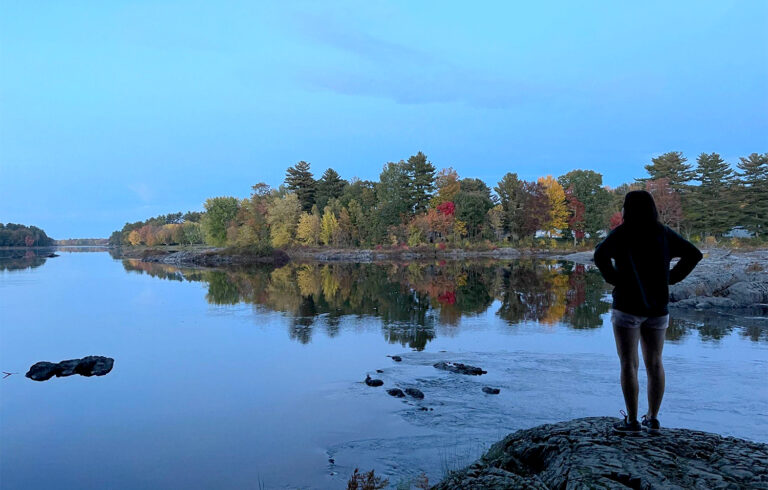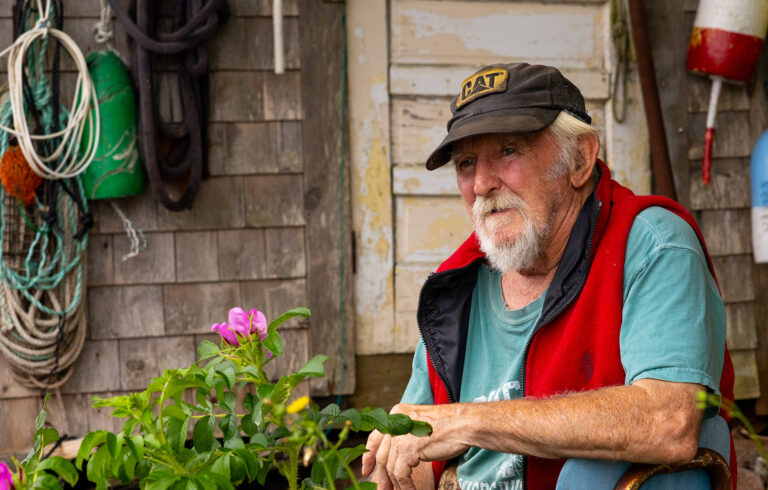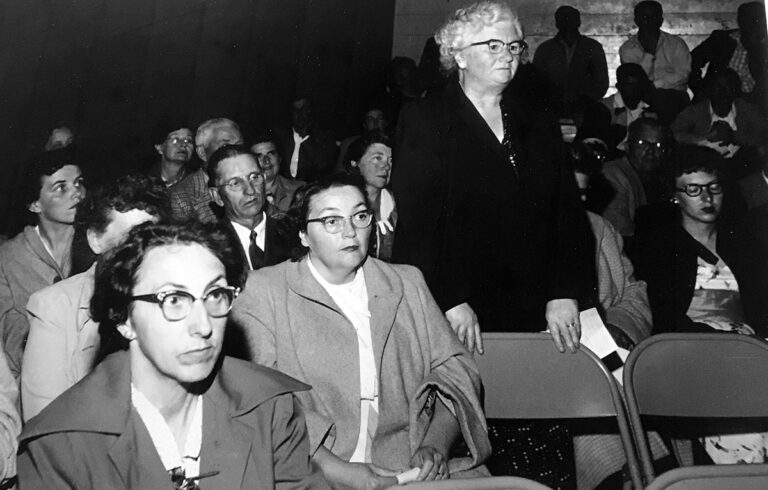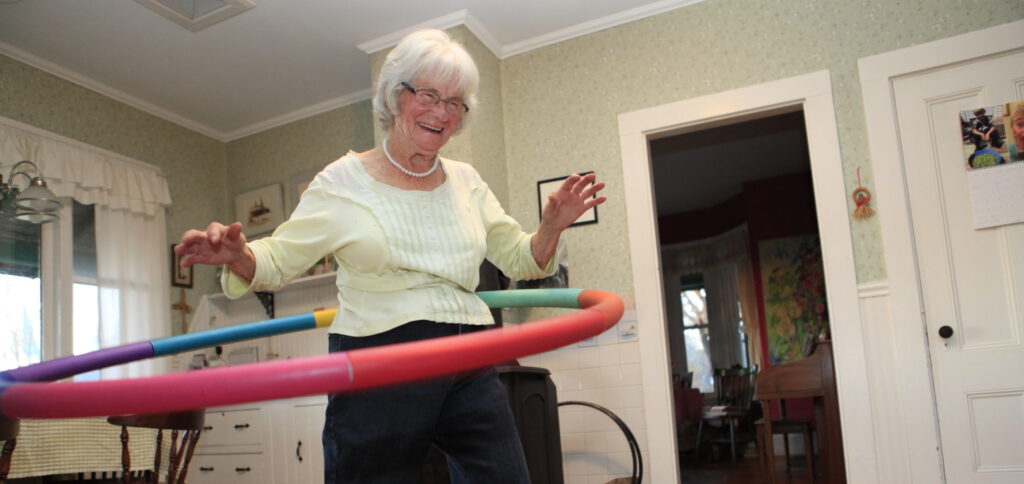
A confession: I never learned to hula hoop. Not enough to keep it from hitting the floor, anyway.
It’s a late November afternoon and quiet on Islesford—also known as Little Cranberry, one of the five that make up the town of Cranberry Isles—and I’m about to get my first official hula hooping lesson from Anna Fernald.
There are two things you need to hula hoop successfully, Anna says. A good beat and lots of space. After putting on her slippers, she pulls chairs to the edge of the living room and puts on a Mark Knopfler and Emmylou Harris album of duets. She cranks the volume so you can hear it in any room in the house.
“OK,” she says, picking up one of her three colorfully striped hoops. “You’re counting on your body to hold it up, but you want to have the hoop cling to you and do the work.”
And with a good twist of her wrist, the hoop is up and going, smooth and steady. She takes small steps around the room with her arms out to her side, letting the drums and Knopfler’s guitar on “Beachcombing” keep her in time. At one point, the hoop begins to wobble a little and Anna laughs as she corrects it, becoming newly focused. The song ends and she grabs the hoop, pulls it over her head and with a great big smile, she holds it out to me.
“Your turn!”
She will be 86 this year.
It’s rare to see Anna not smiling. Even when she’s worried or thinking about something seriously, her eyes sparkle and dance. She’s someone who’s apt to give you a big hug when first meeting you, taking your hands and saying, “Oh, I’m just so glad you’re here!”
The matriarch of one of Islesford’s larger families and a welcoming ambassador to her island home, she was born in Ellsworth and grew up in Salisbury Cove, eight miles from Bar Harbor. Her father, a laborer, often worked as a plumber and mason and even helped to build the Cadillac Mountain Road. Her mother took care of her and her four siblings, including a sister who was mentally handicapped.
“Now here I am, 66 years later,” she says.
What was it like to come out to the island?
“Awful. The day I moved out from my parents’ house, I stayed up in my bedroom and cried. Warren came in and asked, ‘What’s the matter, dear?’ and I said, ‘You know what the matter is.’ I did not want to come out here.”
Of course, she had to: Warren’s family had been on Islesford for generations and it was expected that he would continue fishing and start his family on the island. His grandfather bought their house from a Coast Guard captain four years earlier for $1,000 and when giving it to Warren and his new bride, he said his one condition was that he wanted them to fill it up.
“Well, we did,” Anna says. “And then some.”
Almost every night, and especially during the summer, the house would be crammed with people. In addition to their six children—Bruce, Mark, Dan, Karen, Kelly, and Paul—there would be friends, neighbors, and sternmen living in the attic, relatives visiting for the summer.
“You never knew who you were going to see for dinner,” she says. “I was going through about a bag of potatoes every night.”
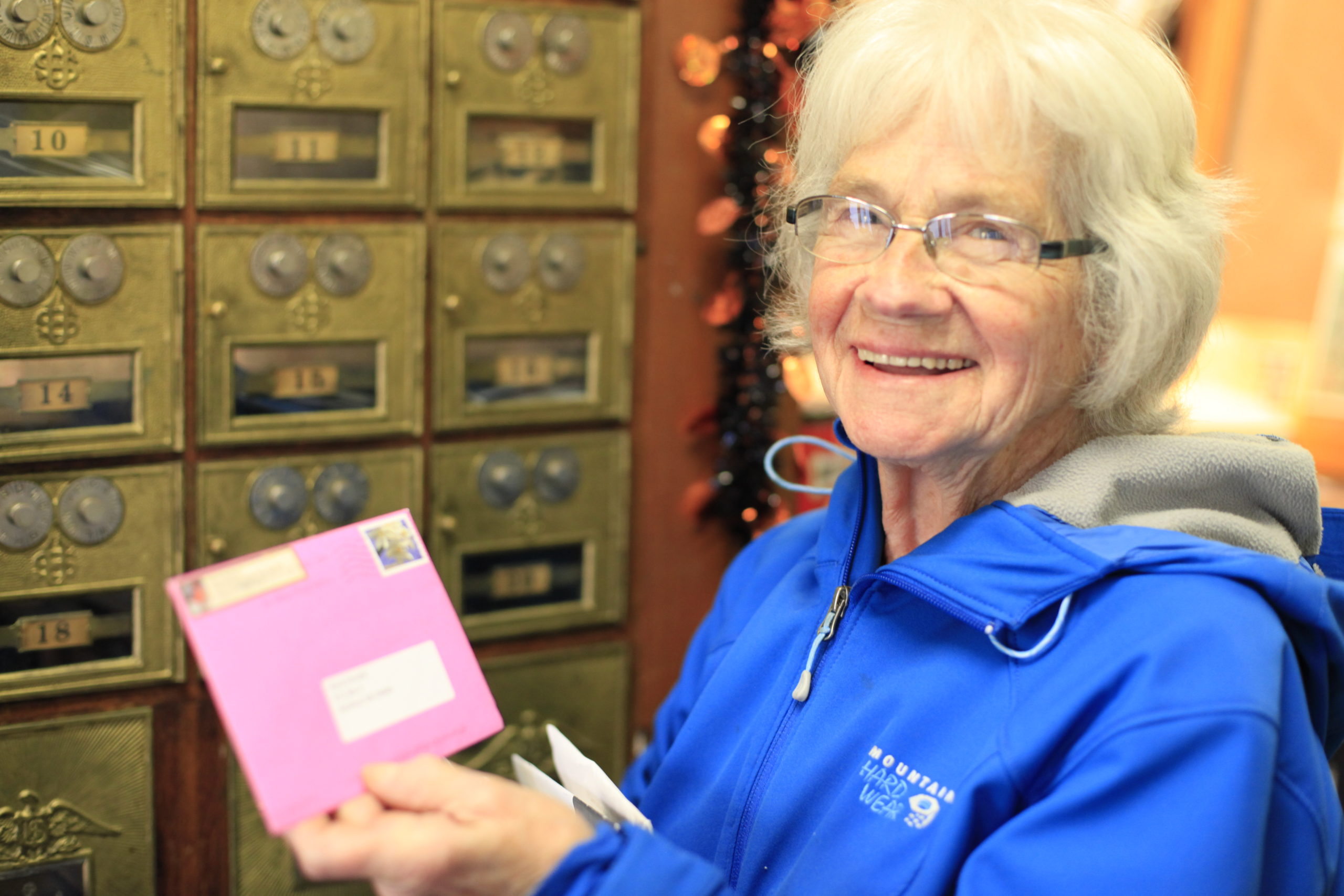
It was the same when I was out on the island last summer to film the island’s second annual community “rowathon,” a 10-kilometer fundraising row around the island. Over the course of the morning on the day of the event, nearly everyone who was involved in the race passed through her living room to squeeze onto the sofa and loveseats and drink a cup of coffee while Anna moved quickly between the living room and the kitchen to get people a warm-up or serve yogurt with her famous cranberry jam or bring out a photo album to share. Later that day, she was perched at the bow of a Super Mario Brothers-themed rowboat dressed as Princess Peach, complete with parasol.
“Oh, it’s a blast!” she laughs. “There’s always something going on, someone coming in, needing something to eat, telling a story. Some people ask, ‘How do you do that?’ and I say, ‘How do you not do it?’”
She has made a point of keeping at least one of her spare bedrooms consistently filled: several Island Institute Fellows have boarded with her in the past and the administrative assistant for the town’s select board has been living in the attic for six years now. She thinks having had a lively house full of people of all ages is the reason her children are as outgoing and personable and caring as they are. It might also be how she stays so youthful.
“I think for me and my age, I’m the only one who’s out and about and keeping active. And I don’t know why that is unless I’ve forced myself to do it, because I want to keep myself that way. Some people as they get older, they get focused on their projects, whether that’s quilting or woodworking or whatever. Mine is staying active and hanging out with people, I guess.”
Anna takes two walks around the island a day. One after coffee and Bible study in the morning and one in the late afternoon before she starts cooking dinner. She points out where everyone lives, who lived there before, the remodeling one family is doing, the hard times another is having. The island is starting to slow down, she says, not just seasonally, but as a community: a cyclical ebb that most islands experience.
A wave of people has moved off-island for one reason or another. There are fewer regular town events. And for the next two years, Islesford students will be going across the water to the newly reopened Longfellow School on Great Cranberry Island each day, leaving Islesford’s Ashley Bryan School empty. She misses the kids. She often stops at the school—a quick walk across the road from her house—and sits on the swing set, wishing she could see them at lunchtime.
On the way out to the island’s southern beach, she stops at the small cemetery where Warren, several generations of his family, and many of her contemporaries are buried. It’s been increasingly difficult for Anna to lose members of their small community; a few years ago, two of her close friends passed away within two days of each other. Warren had died the year before. Pointing out who was who, she finally comes to Warren’s headstone which is, by far, the most beautiful.
One night, years ago, when they were looking up at the sky during an after-dinner walk, Warren said, “When I die, I hope God lets me fish the Big Dipper.” That stuck with Anna so when he died in 2005, she asked Rick Alley, an island fisherman and artist, to draw Warren’s lobster boat—F/V Mother Ann—among the stars, and then had the image engraved on his headstone.
“He was a real people person, too,” she says. “He had his summer shop down on the dock and tourists would come off the boat and talk to him while he fixed traps. Some people get annoyed with that sort of thing, but he loved it.”
Before she heads home, she stops in at the post office. She had been in earlier, too, hoping the mail had been sorted. Now, among a pile of bills and magazines she pulls out of her postal box is a small purple envelope. It’s what she’s been waiting for.
“A card from David,” she says, holding it to her chest and grinning ear to ear. “I get one every day.”
In the early 1990s, Anna attended a Christian retreat in Bar Harbor and has done so every year since. Because Warren wasn’t interested, she went alone. Each summer, she’d make more friends, including David, with whom she has kept in touch over the last 25 years. Recently, they connected and have developed a relationship that has gotten more serious in the last few months.
“If you told me that at 85, I’d be dating an accountant from Ellsworth who’s 15 years younger, I’d say you’re crazy,” she says, blushing a little. “But you never know what’s around the next bend!”
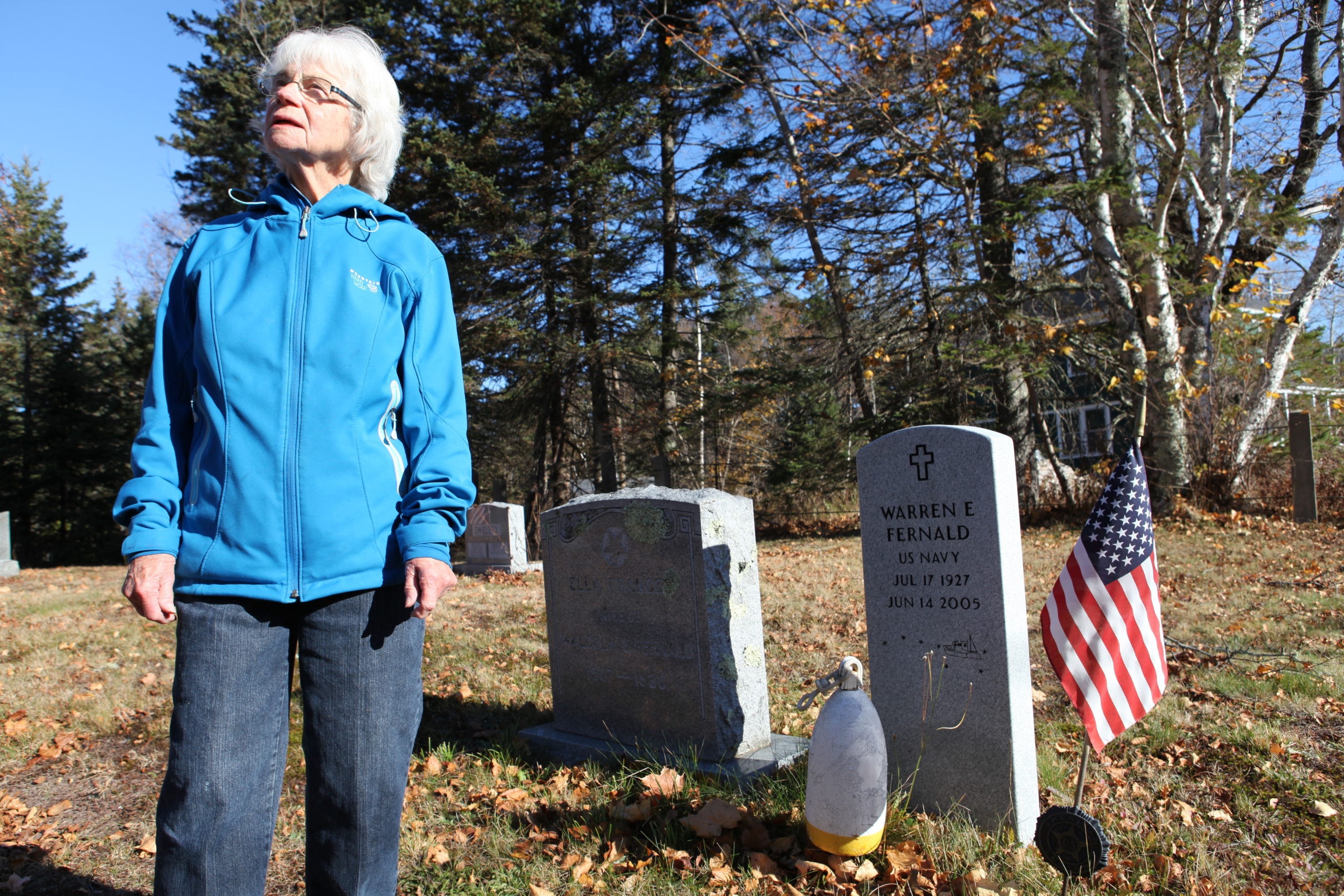
They have been writing and emailing one another every day while he’s in Florida for the fall. In January, he’ll return to Maine and come visit her on Islesford. Anna also foresees spending more time on the mainland with David.
“There’s less keeping me here day to day, and I’m more willing now to leave for a while and come back when I want to,” she says. “Not that I ever want to leave the island forever. I don’t. This is home.”
Back at Anna’s house, a beef stew is being mopped up with biscuits around the dining room table. Two of her four sons, Bruce and Paul, and two neighbors are over for supper tonight. Over warm gingerbread, everyone shares their own story about driving in bad weather as news of a pre-winter snowstorm emerges.
The phone rings in the next room and Anna excuses herself.
Twenty minutes later, she comes back in with a smile that refuses to leave her face.
“That was David, calling from Florida,” she says, sighing. “He says hello to everybody.”
She reaches over to Bruce and lays her hand on his.
“I can’t wait for you to meet him.”

